Are you interested in the latest trends impacting downtown revitalization?
Is your community capitalizing on current opportunities to transform its urban core into a more vibrant place?
…Or is your community missing out on the wave of downtown development taking place in cities across the US?
If you answered ‘yes’ to any of the questions above, you’ll want to read this blog post.
This blog is based on a presentation I recently gave at the Downtown Eau Claire, Inc. Annual Awards Dinner. If you want to see a video of the presentation this blog is based on, check it out here. The video is not the keynote presentation I gave at the Downtown Eau Claire, Inc. annual awards banquet. It was filmed during a presentation was given to a smaller audience the following afternoon; however, there is a bonus at the end of the video. I include 5 stories of innovative businesses I’ve come across in my travels that have played a unique role in the revitalization of their communities.
First, a note about Eau Claire, the inspiration for this blog post: Eau Claire is a mid-sized Wisconsin community with a city population of 70,000 and a metro area population of 150,000. The city sits about 1.5 hours east of Minneapolis-St. Paul. Downtown Eau Claire has become a vibrant place in the last several years. Thanks to the efforts of local business and government leaders, the community is in the midst of a downtown building boom. Hundreds of new urban residential units have been built since 2010, with hundreds more under construction and in the pipeline. Multiple new hotels are in various stages of development. Large business expansions such as Janf Software & Royal Credit Union are investing in new downtown HQs. At the same time, small businesses are opening up in downtown Eau Claire. All of this is supported by a growing menu of urban amenities including bike paths, pedestrian bridges over the city’s two rivers (Chippewa River & Eau Claire River), and numerous bars & restaurants is promising to attract even more people, jobs, and investment.
What follows is a list of 10 trends impacting downtown revitalization efforts, including nearly 30 best practices from communities across the US. You can view each of these trends not just as something “happening to downtowns” but also as opportunities that cities can capitalize on. Here are the 10 major trends and some of the great things cities are doing in response to these trends.
Downtown Trend #1: Urbanization Across the US.
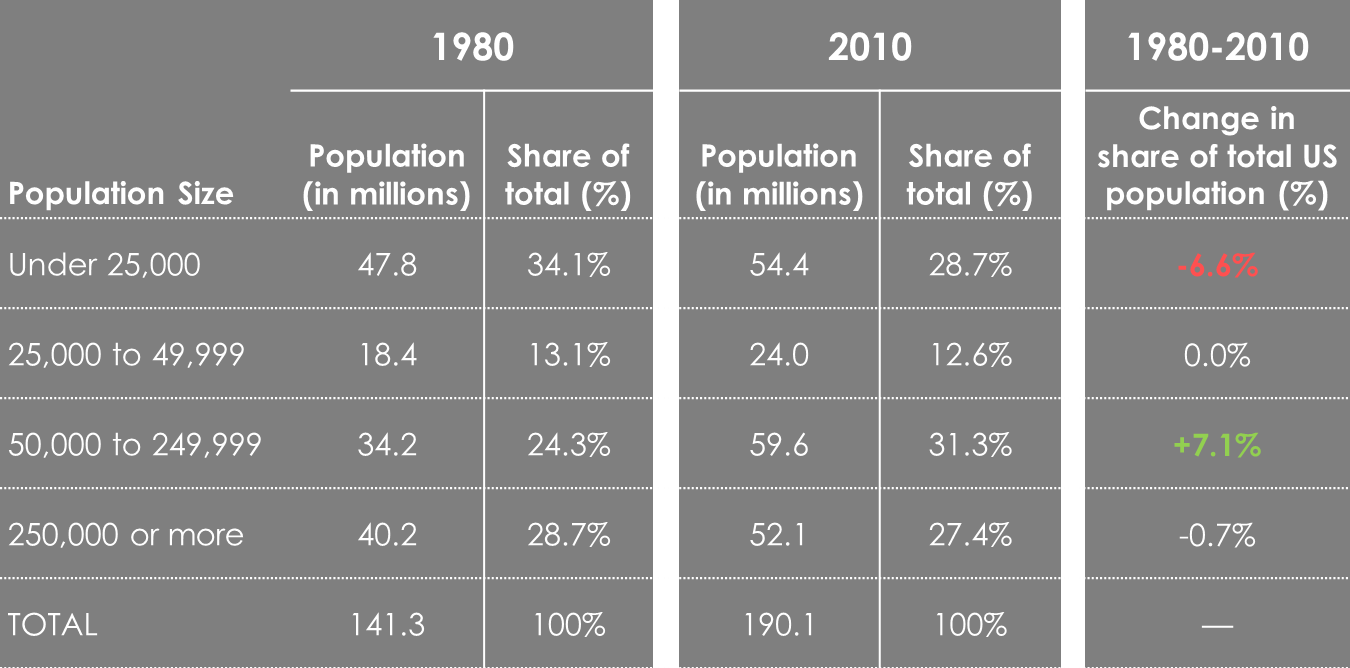
Share of US population by size of incorporated place, 1980-2010. Source: US Census Bureau, Population Estimates Program.

Share of US population by size of incorporated place, 2010-2014 . Source: US Census Bureau, Population Estimates Program.
From 1980 to 2010, incorporated places of all sized gained residents. However, only cities with populations between 50,000 and 250,000 gained a significant share of the total US population. In more recent years from 2010 to 2014 an interesting shift happened. Mid-sized cities are still gaining share of total population, but now large cities (those with populations above 250,000) are gaining an even greater share of residents.
Downtown Trend #2: Downtown Residential Growth.

Downtown population growth among100 largest US cities, 2000-2010. Sources: US Census Bureau, Population Estimates Program, urbanSCALE.com.
Right after starting urbanSCALE, I analyzed the downtowns of the 100 largest cities in this 3-part series of blog posts, including growth/loss of residents in downtown districts. I also looked at the 1-mile and 3-mile radius surrounding the downtown areas of the 100 largest cities. From 2000 to 2010, roughly half of cities were losing residents in their larger urban core (the CBD + 3-mile radius). But the vast majority of cities gained residents in their downtown.
75 cities gained residents in their CBD, while only 20 cities lost downtown residents from 2000 to 2010 (5 of the 100 largest cities do not have downtowns, which is why the numbers don’t add up to 100). Places like Cleveland, Memphis, Phoenix, and San Antonio (among others) lost significant numbers of residents in their larger urban core (CBD + 3-mile radius), while gaining residents within the boundaries of their downtown.
Another example is the Minneapolis-St. Paul region, where the core cities grew more slowly than the surrounding metro area from 2000 to 2010, but have grown faster than the rest of the region from 2010 to 2014. If anything the trend of downtown residential growth seems to be accelerating.
Downtown Trend #3: Public Sector Leadership.
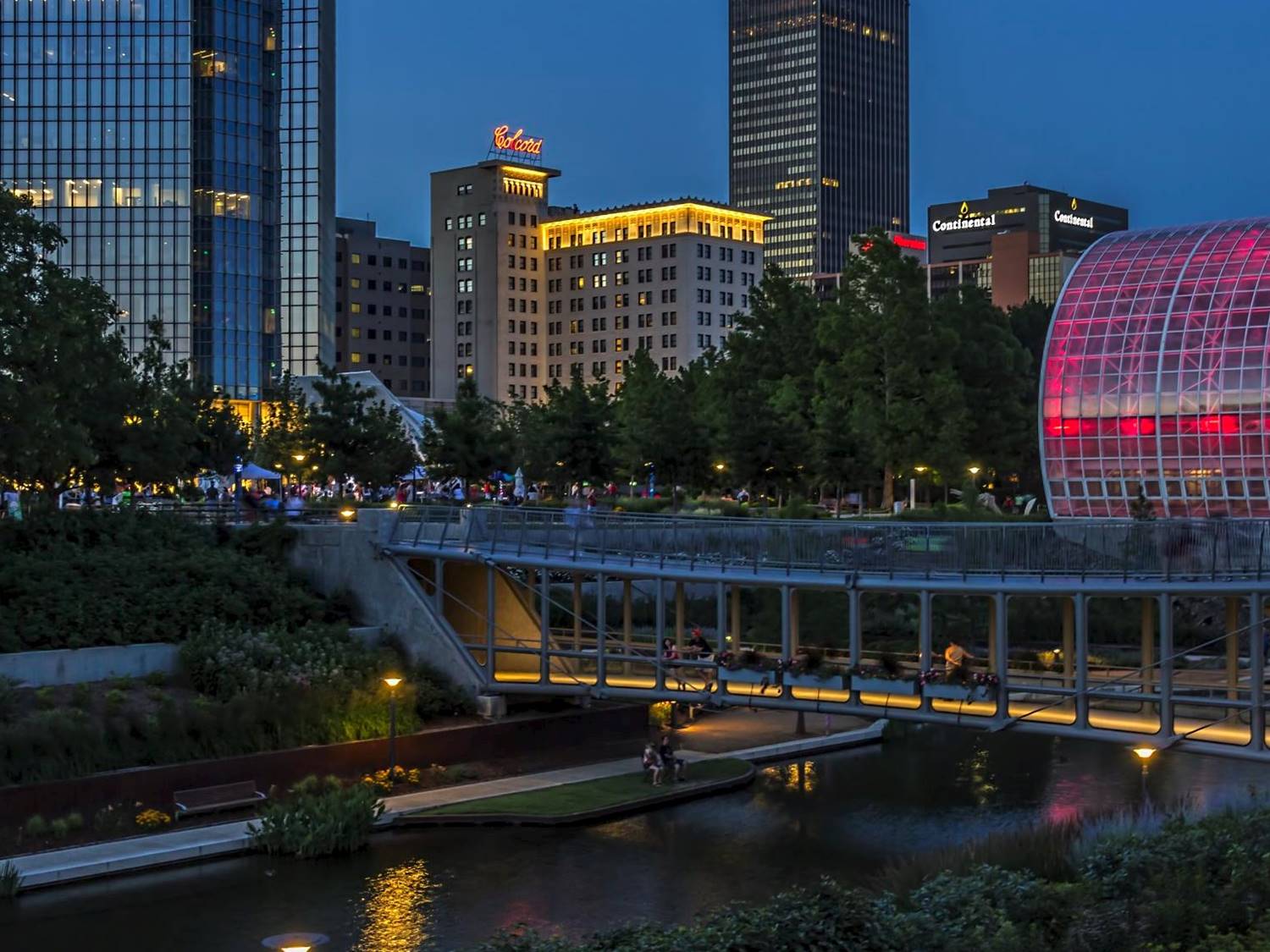
Image Credit: Downtown Oklahoma City by Kool Cats Photography Via Flickr
The private sector is responsible for roughly 90 percent of the built space in US cities. However, the public sector plays a lead role that influences where and how development happens. Many cities benefit from strong public leadership that has led to incredible downtown transformations.
- Oklahoma City’s MAPS program is an amazing story and example of public sector leadership for downtown revitalization. Oklahoma City is a very conservative political environment, not a place you would expect to spend a lot of public dollars to stimulate the economy. Nonetheless, city leaders responded to the community’s low state of affairs in the 1980s and 1990s by implementing the MAPS (Metropolitan Area Projects) program. MAPS is a temporary sales tax increase to fund quality of life improvements, mostly in the downtown district. It was so successful the first time around that they did a second MAPS, and are now implementing a third one. All of this has led to a vibrant city center.
- Chattanooga, Tennessee offers another example of a remarkable turnaround led by the public sector. In 1969, Walter Cronkite announced that Chattanooga had become “the dirtiest city in America” based on findings from the US Environmental Protection Agency (EPA). This dubious distinction emboldened city leaders to chart a new course for the community, beginning with a major downtown overhaul. The River City Company was established, a public-private entity to drive redevelopment efforts in the urban core. Similar efforts to spark innovation have led to a publicly-owned high speed internet that Chattanooga’s current Mayor Andy Berke calls “the fastest, cheapest, most pervasive internet in the Western Hemisphere”. Today, the city center is thriving, with thousands of new apartments, new retail, and amenities. Bruce Katz from the Brookings Institution recently profiled downtown Chattanooga’s emerging role as an innovation district in this article.
- Bay City, Michigan shows us that small cities can also use public sector leadership to spark a major downtown rejuvenation. Bay City is one of the best urban rebounds in Michigan. As recently as the 1980s, most of the storefronts in downtown Bay City were vacant and boarded up. Since then, community leaders from the public and private sector worked to attract investments, businesses, and new facilities to re-invigorate the downtown. Today, downtown Bay City is a vibrant, walkable district with an increasing number of residents, businesses, and amenities. Some of the most transformative investments in recent years include the DoubleTree Hotel and events center, the renovated City Hall building, and the Uptown Bay City mixed-use development. Uptown Bay City (which includes new rental and condo housing, new office and medical space, a hotel, restaurants, and shops) is a great example of the type of public-private collaboration needed to achieve success in downtown revitalization. I’ve been able to see this transformation first-hand through my work with the East Michigan Council of Governments on two consulting engagements over the last couple of years for the larger eight-county East Central Michigan Prosperity Region.
Downtown Trend #4: Private Sector Leadership.
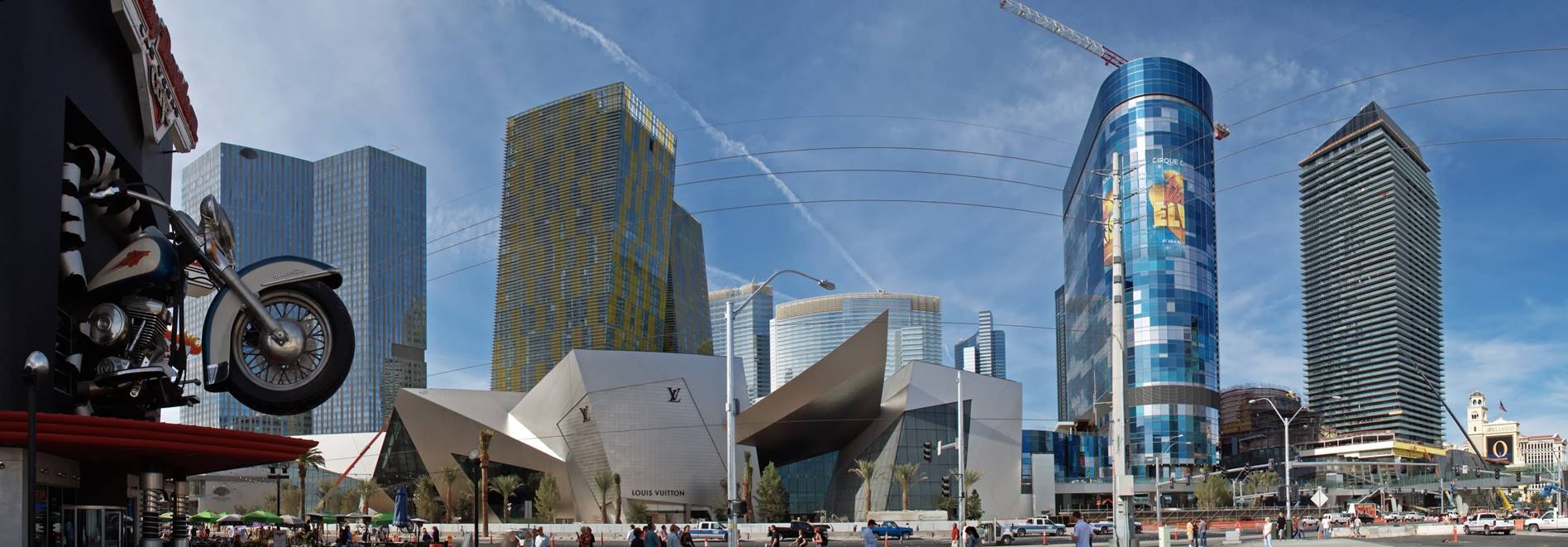
Image Credit: City Center by John Fowler via Flickr (CC BY 2.0)
In late 2015, Smart Growth America issued a report titled “Why American Companies Are Moving Downtown”. In partnership with Cushman & Wakefield and the Center for Real Estate & Urban Analysis at George Washington University, the report analyzed nearly 500 companies that relocated or expanded to walkable downtowns between 2010 and 2015. One of the major findings is that the companies’ new locations are far more walkable than before. The average Walk Score of companies’ prior locations was 52…not very walkable. The average Walk Score of companies’ new locations is 88…very walkable.
Aside from expanding business operations into walkable downtowns, the other growing trend from private sector leaders is their active involvement in creating a vibrant, mixed-use community. They are no longer interested in just a pure real estate deal that plops down another sterile office tower into a downtown. Increasingly, private sector leaders see themselves as partners in creating a community that supports and benefits from their business locations.
- Tony Hsieh and the Downtown Project in Las Vegas are a unique story of a new corporate HQ location with a much bigger ambition to impact urban redevelopment. Hsieh is the founder of Zappos, the online retailer which was acquired by Amazon in 2009. Hsieh moved Zappos into the former Las Vegas City Hall, from suburban Henderson, Nevada in 2013. As part of the company’s move into downtown Las Vegas, Hsieh launched the Downtown Project, an effort to transform the city’s urban core into a walkable, mixed-use district. The Downtown Project is making headway on its mission to “help make downtown Vegas a place of Inspiration, Entrepreneurial Energy, Creativity, Innovation, Upward Mobility, and Discovery, through the 3 C’s of Collisions, Co-learning, and Connectedness in a long-term, sustainable way.”
- Dan Gilbert & Rock Ventures are in the midst of an unprecedented private sector-led urban transformation in Detroit, Michigan. In September 2015, I attended an Inner City Economic Summit in Detroit where I enjoyed a presentation from Matthew Cullen, CEO of Rock Ventures, which is Dan Gilbert’s real estate arm. You can read more about that event in this urbanSCALE blog post. Since 2010, Rock Ventures has been responsible for the creation of 13,000 jobs, over $2 billion in investment, and the renovation/redevelopment of 13 million square feet of building space (office, residential, retail). While many of the surrounding neighborhoods in Detroit continue to decline, there are more signs of positive momentum in downtown and Midtown than there have been in decades. It will be fascinating to watch over the next several years to see if Gilbert’s efforts, along with those of other private sector leaders, begin to spill over into a citywide revitalization.
- Graham Weston & Geekdom in San Antonio, Texas are another example of private-led downtown development efforts. Weston is a co-founder of Rackspace, San Antonio’s largest tech company. And Geekdom is a unique startup magnet in downtown San Antonio that is sort of like a tech coworking space on steroids. Geekdom has been so successful, that it has 900 members as well as dozens of eager startups on a waiting list for dedicated offices in the space according to this article from Kristen Mosbrucker in the San Antonio Business Journal. Weston is also currently pushing forward plans to develop the city’s first new office tower in more than 3 decades.
Downtown Trend #5: Leveraging Higher Education.

Image Credit: ASU Trip by Mike Dunn via Flickr (CC BY-NC-SA 2.0)
Another big opportunity for communities is to leverage their higher education institutions to enhance the activities taking place in the urban core. Whether through creating a new campus or leveraging an existing college or university, higher education is a centerpiece of many successful revitalization efforts.
- Arizona State University’s downtown Phoenix campus is one of the most ambitious and strategic efforts to create a new higher education presence in a downtown. With an investment of nearly $225 million, the new campus will ultimately house 15,000 students and nearly 2,000 faculty and staff in the heart of Phoenix.
- Colorado State University in Fort Collins is a great example of an existing university that plays a critical role in a city’s strong quality of place. CSU is just southwest of downtown Fort Collins, but the neighborhood between the two anchors has evolved into an extension of the vibrant downtown. And the joint UniverCity Connections partnership between the university and the city is a hallmark of the mutually benefitial relationship between both entities.
- Texas Tech University is located about one mile west of downtown Lubbock. When I was a kid growing up in Lubbock in the 1990s, the neighborhood between the university campus and downtown was known as the “Tech Ghetto”…and this was arguably the least desirable part of the region. I was fortunate enough to visit Lubbock again in 2014, through work on a strategic plan for the Lubbock Economic Development Alliance. Over the 10+ years, the zone between Texas Tech and downtown has been transformed into the Overton District, an upscale mixed-use neighborhood with thousands of urban housing unites, retail space, hotels, and quality public spaces. This new district was spearheaded by the McDougal Companies (a local real estate developer) and is steadily marching east towards downtown, which is the next wave of revitalization waiting to take place over the next couple of decades.
Downtown Trend #6: Utilizing Rivers & Waterfronts.
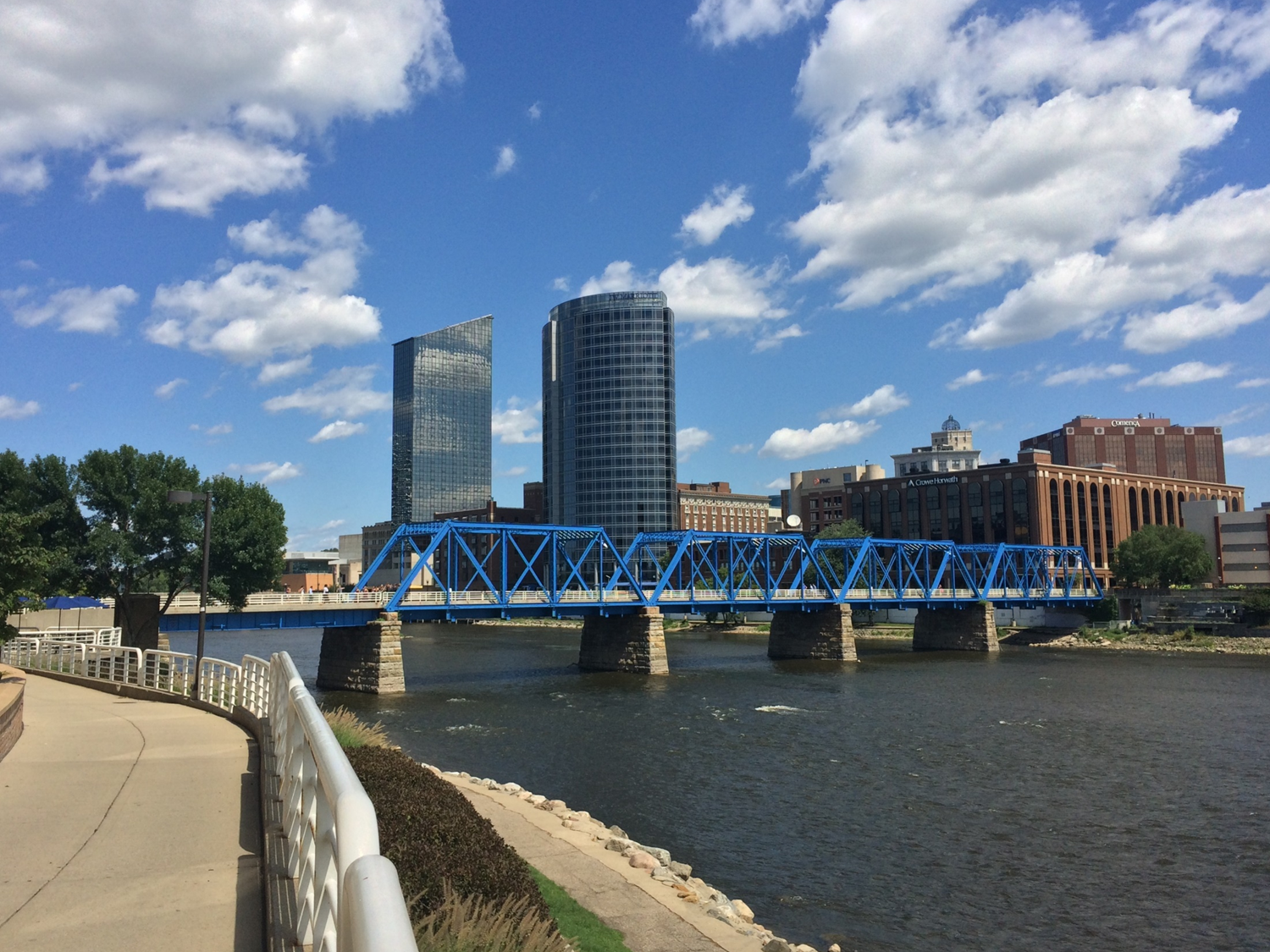
Image Credit: Blue Bridge Downtown Grand Rapids by Steven Depolo via Flickr (CC BY 2.0)
Nearly every city has a river or other sort of waterfront (a lake or ocean) running through or near its downtown. Far too many cities have ignored these waterfronts for decades, effectively turning their back on them. Fortunately, community leaders have started to wake up to the incredible opportunity represented by their urban waterfront zones.
- Grand Rapids, Michigan is one community that has not really utilized its riverfront. But this is changing. Some local business leaders have bold plans to reintegrate the rapids (the city’s namesake) into the Grand River which runs through the community’s CBD. This will help accelerate the city’s urban renaissance which has already made Grand Rapids a hotspot for attracting Millenials and new businesses among Midwest cities.
- Bend, Oregon and the Deschutes River are inseparable. Of all the cities I’ve visited, no other city integrates its river more seamlessly into the urban fabric more than Bend. Whether through the downtown area where there are coffee shops with backyards opening up onto the Deschutes River. Or the Old Mill District which sits along the river’s eastern shore. Or one of the many playgrounds or trails along the river. Every city can learn something about how Bend has turned towards its waterfront.
- Pueblo, Colorado and the Arkansas River are a great example of creative use of public investments to create an urban waterfront amenity. As a kid, my family used to drive from Lubbock to Denver each summer. We often stopped in Pueblo and there was nothing memorable about the community. Fast forward 20 years. I made the same drive with my wife (Cyndy) and son (Gavin) in the summer of 2014 and we happened to arrive in Pueblo around lunchtime. It’s amazing what they’ve done with their downtown in the last decade. By diverting water from the Arkansas River, which runs near downtown Pueblo, they have created a mini San Antonio-style Riverwalk complete with sidewalk cafes, gondolas, and new craft breweries.
Downtown Trend #7: Craft Brewing Sector.
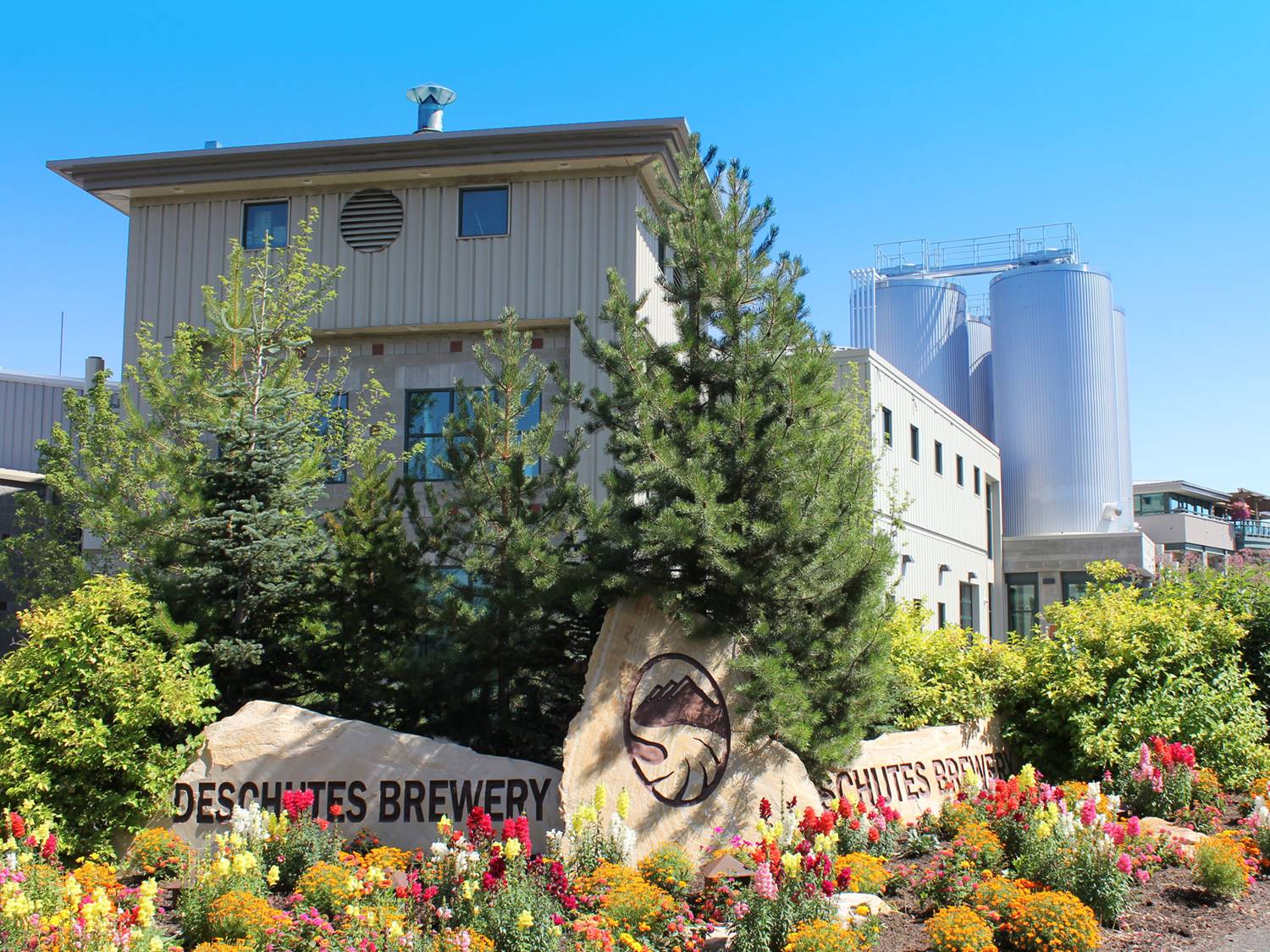
Image Credit: Deschutes Brewery-Production Facility by U.S. Department of Agriculture via Flickr (CC BY 2.0)
Craft brewing is a major growth industry. According to statistics published by the Brewers Association (BA), there were nearly 3,500 breweries in the US in 2014, an increase of roughly 2,000 breweries from just 10 years earlier. Of these, 99 percent were craft-brewing operations. In 2014, craft brewers represented 11 percent of the total volume of beer produced, but in dollar terms, craft beer accounts for 22 percent of the roughly $101 billion beer market in the US.
Neil Reid and Jay D. Gatrell write about the significant economic development opportunities arising from the expansion of craft brewing in the Fall 2015 issue of the IEDC Economic Development Journal. But beyond job creation and capital investment, craft breweries are playing a significant role in urban redevelopment projects and talent attraction efforts in communities across the country.
- Bend, Oregon is one of the foremost craft brewing centers in the US, with more breweries per capita than any other US. People in other cities may argue this point, but Bend is easily on anyone’s top 10 list. With Deschutes Brewery leading the charge, the city has leveraged its robust brewing scene to attract talent, especially Millenials, entrepreneurs, and young professionals. Deschutes is less than one-half mile from downtown and there are many other craft breweries in and around Bend’s city center including McMenamin’s Old St. Francis School Brewery.
- Richmond, Virgina attracted Stone Brewing (based in San Diego, California) to create their East Coast expansion. This new brewery is an important part of the city’s urban redevelopment efforts along the James River near downtown Richmond. There is a growing trend of major craft breweries in the Western US expanding their reach with second locations in the Eastern US to access a larger market.
- Asheville, North Carolina (like Bend, Oregon) is another small city that fights way above its weight class in the craft brewing world, with several Beer City USA titles under its belt. Asheville has numerous home-grown breweries, but it has been able to lure expanding West Coast breweries more than any other city in recent years starting with Chico, California-based Sierra Nevada Brewing and more recently Fort Collins, Colorado-based New Belgium Brewing. New Belgium is currently building their new facility in Asheville’s River Arts District, which will become a centerpiece of the redevelopment efforts connecting the city’s CBD to the French Broad River. In fact, Asheville has been so successful as a craft brewing center, that it did not win the most recent brewery expansion project–Deschutes recently announced its East Coast location will be in Roanoke, Virginia instead of Asheville)–most likely because Deschutes wanted to be a game-changer in a city with a smaller, emerging craft beer scene. All of this is helping the city to attract new talent and new businesses. I was able to appreciate Asheville’s craft brewing sector and other economic strengths in person during a consulting engagement in 2015 to create a new strategic plan for the Asheville-Buncombe County Economic Development Coalition.
Downtown Trend #8: Festivalization.

Image Credit: SXSW via http://sxsw.com/sites/default/files/Mindy%20Kaling-49_AmandaStronza.jpg?itok=EkLEIzL-
Music festivals and art festivals are not new. Neither is the use of festivals to promote cities as destinations for tourists and visitors. But the use of festivals for strategic economic development purposes has emerged as a significant new trend. Jonathan R. Wynn, a sociology professor at the University of Massachusetts-Amherst, recently wrote Music/City, a book that explores this trend of “festivalization”. Wynn’s book explores the role of music festivals in the evolution of a city’s brand and image, as well as its success in broader economic development. It focuses on three iconic festivals and how they’ve shaped their cities: Austin’s South by Southwest, Nashville’s Country Music Association festival, and Newport’s Folk Festival. Here is Richard Florida’s interview with the author.
- Austin, Texas and SXSW is a prime example of how a festival can become an economic development engine. This article by Lilly Rockwell at the Austin American-Statesman highlights the growing number of communities using SXSW Interactive as a platform to market themselves as locations for business recruitment and talent attraction. Cities like Atlanta, DC, and Tulsa along with foreign countries such as Mexico, Japan, and Germany were all at this year’s SXSW conference a couple weeks ago touting their advantages to the global tech community. It’s fascinating to watch SXSW Interactive emerge as one of (perhaps the?) premier tech conferences in the world. Especially given its humble beginnings as a small music festival. The festival’s success adds immensely to Austin’s ongoing development as a thriving urban community.
- ArtPrize in Grand Rapids, Michigan has been a massive success story. Initiated as a bold new “social experiment” by local billionaire Rick DeVos, ArtPrize has become an important factor in the community’s economic success. The event brings in over 400,000 attendees into downtown Grand Rapids and has elevated the city’s brand on the national and global stage. ArtPrize is billed as the most attended art event on the planet.
- Fresno, California and the Rogue Festival offer an example of how smaller events can enhance the quality of place in urban districts. The quirky arts event draws in 10,000 visitors over 10 days. Rogue Festival breathes life into Fresno’s quirky Tower Arts District, a unique urban neighborhood filled with coffee shops, breweries, theaters, and thrift shops.
Downtown Trend #9: The Tech Sector.

Image Credit: Green Water : Block 23 Office Tower via Trammell Crow Company
There has been a big shift in the tech sector over the last decade. There was a time when technology firms clustered in self-contained campuses in suburban areas. Those campuses still exist. But the biggest growth among tech firms is now taking place in downtowns and walkable districts in cities across the US.
- Austin, Texas is known nationally as a hub for technology companies. Until recently, most of the job growth in tech firms has taken place outside of the city’s CBD. The landscape is changing. In early 2015, it was leaked that Google has committed to occupy 200,000 square feet of a 500,000 square feet office tower currently under construction in downtown Austin. This is part of a larger trend in Austin of tech firms expanding and/or relocating their offices into the CBD and close-in urban neighborhoods to take advantage of the urban amenities that are so highly sought after by today’s workforce.
- General Electric (GE)’s relocation of its corporate HQ from suburban Connecticut into downtown Boston’s Seaport District is a perfect example of the growing corporate preferences for walkable locations. But it’s much more than a relocation. It’s a re-positioning of the entire company to be more technology-driven and more focused on attracting talented workers.
- OtterBox in Fort Collins is another example of a tech company locating intentionally in a vibrant downtown district. And OtterBox has expanded its downtown footprint, re-affirming the company’s belief in Fort Collins’ city center.
Downtown Trend #10: Coworking.
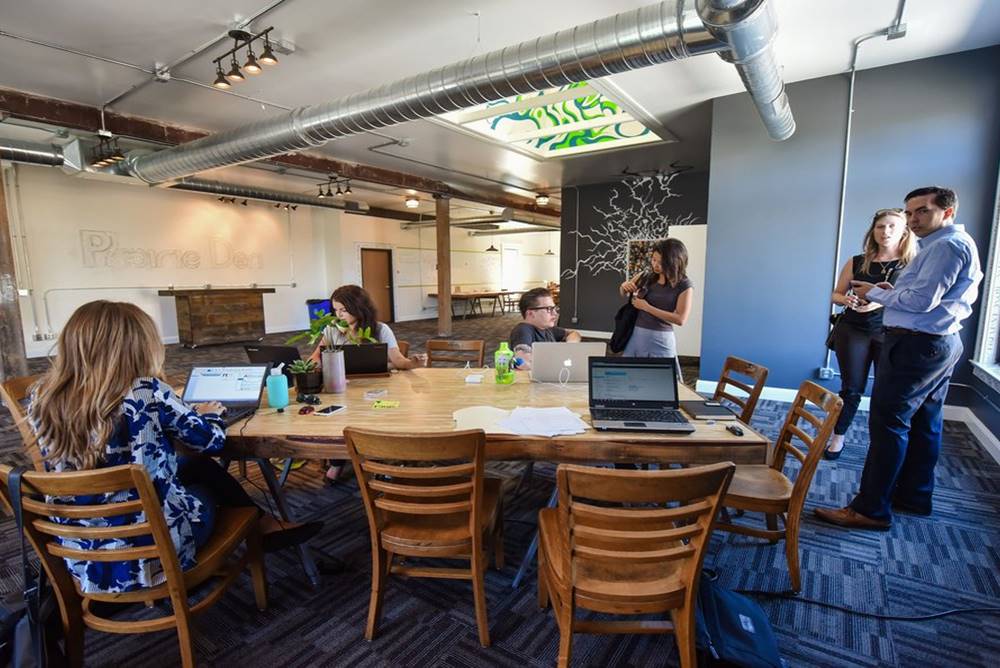
Image Credit: Prairie Den by Bri Lee via Yelp
The ongoing shift toward a more flexible economy and workforce have created a growing demand for coworking spaces in cities across the country. This is a major trend and opportunity for downtowns and urban districts. WeWork is the most successful company in this space. If you’re not familiar with WeWork, it’s well worth the 20 minutes to read this article by Sarah Kessler in Fast Company describes Adam Neumann’s vision for the future of WeWork founder Adam Neumann. If you don’t have 20 minutes to spare–or 20 more minutes, because you’ve already spent nearly 20 minutes reading this post :)– just read this snippet: “Neumann and his cofounder, Miguel McKelvey, founded WeWork in 2010 with a simple business model: The company rents office space from landlords wholesale, breaks it into smaller units, and subleases it at a profit. WeWork, which now has 77 locations and more than 50,000 members, says its ultimate potential is much bigger—and investors agree. In February 2014, WeWork’s backers valued the company at $1.5 billion; by last week, its valuation had jumped to $16 billion, making WeWork, on paper, the world’s 6th most valuable private startup.”
However, the coworking trend is not only for large cities and dense downtowns with high-priced real estate. Many small and mid-size cities have successful coworking spaces that are playing an important role in supporting entrepreneurship and innovation.
- The Prairie Den in Fargo, North Dakota is a thriving coworking space that was created by the Emerging Prairie organization. Emerging Prairie is a grass-roots effort that has galvanized progressive business and community leaders in the Fargo region to move the area’s economy forward. The Prairie Den is a key initiative of the group’s activities and is also an important part of the city’s downtown revitalization efforts.
- The Docking Station in Green Bay, Wisconsin is another good example of a coworking space that is a key part of a walkable urban district. The Docking Station is an anchor along the North Broadway corridor just across from downtown Green Bay. The corridor includes several small businesses, restaurants, coffee shops, craft breweries, and other amenities.
- Mojo Coworking in Asheville, North Carolina has served as a catalyst for business growth and professional networking in the city’s CBD since 2011. Mojo has become a downtown destination buzzing with activity and interest, with a waiting list and growing membership in recent months. Soon to join Mojo, will be the Collider, a new coworking and event space in downtown Asheville focused on innovation around the city’s unique climate science assets.
Bottom Line
These trends will continue to impact downtown revitalization efforts for the foreseeable future. And I’ve just shared a small sampling of best practices from cities that have achieved success in capitalizing on these trends to transform their downtown districts. Much more could be written on each one of the trends and each one of the examples, but I’ll stop here and open up the conversation.
Do you agree or disagree with these trends? Are you familiar with other great things you’ve seen your city or other cities do to revitalize a downtown or urban district? What are your favorite examples of urban turnarounds or transformative downtown projects?
See you in the comments section!




Interesting section on rivers and waterfronts. Few communities are established without the attraction of an essential water source. This resource has become underutilized/undervalued in the past half century.
More communities are recognizing the finite quantity and questionable quality of their local sources (think Flint MI). Waterways impact communal health/well-being, leisure pursuits, commerce, industry — you name it.
Not coincidentally, the craft beer breweries appear immediately after the rivers section, upon which they depend for high quality water. Coors in Golden, CO comes to mind.
These two trends should help communities refocus efforts on maintaining and updating all water-related infrastructure (bridges, sewer systems, etc).
Great points about the importance of rivers & waterfronts in cities! Yes, the river & craft beer connections are really strong too.
Great piece. Have you considered exploring Doug Burgum’s work with the Kilbourne Group in Fargo? He and his team have made a massive impact.
Thank you, Greg! Great suggestion. I know just a tad about Burgum’s business success (and selling to Microsoft) in Fargo, and his role as a community investor. Definitely someone else to add to the list as a private sector leader making a big impact in his community.
This is great information.I am in Fredericksburg Va.We have aquired The Embrey Power Plant on the Rappahanock River,Silk Mill ,Ice House Plant and other adjoining properties to Revitilize the Old Mill District.This article is very helpful.If you are in town stop by The Inn At The Old Silk Mill
Ed
Ed- Glad this info is helpful! And thank you for the heads-up about Fredericksburg, VA and the redevelopment efforts you’re involved in there. Haven’t visited Fredericksburg but have heard great things. You know…Bend, Oregon also has a successful “Old Mill District” which you may be aware of.